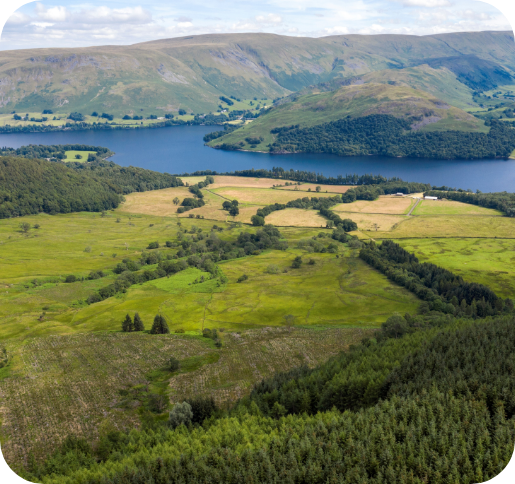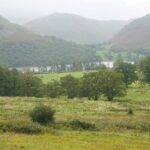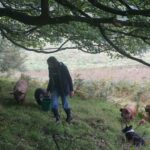LIVING LAB 7: United Kingdom
Gowbarrow Hall Farm
Managed by Sam and Claire Beaumont
General information
Gowbarrow Hall Farm is situated on the south facing shores of Ullswater in the Lake District. It is a family farm, with Sam farming full-time and Claire part-time. The farm was originally bought by Claire’s Grandda and was on annual grazing licences to predominantly sheep farmers before Sam and Claire moved in. Claire’s parents live at the hall and are involved in general decision making and helping with various activities on the farm. There are also two people who have worked on the farm for 40-50 years and still help with seasonal activities such as hay making.
The livestock live outside all the year round. They have beef Shorthorn cattle (about 60 head), 5 Kunekune pigs who spend alot of time in the wood pasture and roaming in and out of the woodland, and 4 fell ponies. They are Pasture for Life certified and have been farming organically for 3-4 years and have already started the certification process.
Livestock production is very much integrated with trying to promote the regeneration of woodland and different plant species. The pigs and cattle turn the ground over and create pockets of opportunity for pioneer species. The cattle are mob grazed during the growing season; predominantly from April through to November / December, using electric fencing and moving the cows every day.
The woodlands are integrated into the farming system predominantly through grazing as wood pasture. From the fell to the valley bottom there is about 385 acres of permanent pasture and many different types of woodland; ranging from ancient oak and deciduous to a big block of commercial plantation, a lot planted in the past 20 years (woodland creation), and a few smaller pockets of ancient coppice woodlands. The farm recently entered into a Higher Tier Stewardship scheme with a focus on about 32 ha (80 acres) of species rich grassland restoration and 81 ha (200 acres) wood pasture creation and restoration. Some hedges were laid under Stewardship, which resulted in brash which has been used to make wood chip. Some wood chip has been composted using a Johnson Su bioreactor (a method of composting where there is no need for it to be turned), which makes a microbial-rich compost that can be applied directly to beds or diluted in water and sprayed across fields.
Sam and Claire saw the benefit of trees soon after moving back to the farm in 2017. When the ‘beast from the east’ hit, the sheep they had in the wood pasture were not affected by the destructive storm. They have observed benefits of having trees, both in winter and summer, for cows to use as shelter from the sun, and for forage – when they are put into a field, they will often go straight to the hedgerows. The biodiversity value is also very important to them – they feel that most ecologists would agree that wood pasture is an ideal habitat for many species, and it is important that encouraging more diversity is a main focus, particularly with so many species being under threat and declining.
General farming approach
Pasture fed – transitioning to organic
Objectives
- Promoting the regeneration of woodland and different plant species (the ‘mob grazing’ system plays a part in this).
- Restoring the wood pasture habitat, encouraging natural regeneration by only winter grazing with cattle (they don’t graze it during the summer), giving the trees a chance to grow saplings and establish themselves before the autumn.
- Reducing the number of cattle through the winter, making sure they’re not over grazing and are not overstocked – the whole farm system is reliant on making sure no feed is bought in. They also don’t buy in straw, making the most of the grass they have.
- Improving the diversity in the sward, favouring the longer rest period and not using fertiliser.
- Improving the biodiversity value across the farm – wood pasture is an ideal habitat for many different species.
- Making the best use of established woodland on the farm and balancing that with new planting /developing woodland.
- Reconciling the divide between being a pastoral farmer versus woodland manager.
- Exploring different ways of managing the land they don’t currently do much with (while cattle currently outwinter, there are various pockets they can’t go in to).
- Ensuring trees are protected against red and roe deer – one of the biggest populations of red deer in England can be found just across the lake from Gowbarrow, and they can swim across! Every tree planted must be protected on some scale.
- Integrating commercial woodland with food production.
- Having a more resilient business – there are two resiliencies: economic resilience and environmental, climate resilience.
Challenges
- Woodland regeneration – The first few years of trying to establish regeneration naturally, alder trees predominantly grew up, which Sam and Claire attribute to a combination of the land having been quite degraded as a result of previous farming practices with higher stocking rates, use of fertilisers etc, so they felt they were starting from quite a low point. This challenge was combined with a huge deer population, and too much browsing of young vulnerable saplings.
- Support in relation to advice and guidance and finances – Sam and Claire have tried to be proactive and have been in regular contact with organisations such as the Woodland Trust, Cumbria Woodlands and Ullswater Catchment Management CIC to get support because they could see it being a barrier, alongside knowing where to source new trees from. They realised it was possible to have a positive impact on regeneration with practices such as less intensive grazing and using electric fencing, without spending much money. But it would only get them so far, to progress faster, it needed investment, help, and support.
- Recognition of wood pasture – It will only be recognised under Countryside Stewardship in the UK if your land is already earmarked as a wood pasture area. At Gowbarrow it was not originally – Sam looked at maps and books written about the Lake District… In James Clarke’s survey of the Lake District published in 1787, he described coming to Gowbarrow and walking through what Sam is convinced was their farm, referring to the woodland floor being littered with decaying stumps of oak trees… The old maps show that there were trees with grassland underneath. Sam and Claire did all their Stewardship application themselves, and firmly believe it’s always worth looking into the history; look at what your farm was, and perhaps could or should be again, it is possible to learn a lot by doing that..
Research goals
They are keen to be involved in as many research projects as possible so that they can demonstrate and evidence practices that can be done in the uplands successfully that change the mindset and practices (where a landscape of treeless hills and stone walls is the norm). They recognise the need for more research to be done in this area.
They view the trees very much as being part of the farm and like to be able to put their cows into the woodlands and to explore and demonstrate the benefits to the woodlands that this can bring. They view cows as being brilliant ecosystem engineers – their cattle move together as a herd and aren’t in one place for very long. They want to be involved in research that demonstrates the benefits of woodland grazing – they haven’t been able to find a lot of research up until now to back it up. They also hope to be able to break down some of the barriers that exist – the Forestry Commission and Natural England have a divided mindset on matters relating to pasture and woodland management.
As part of the living lab, they would like to explore further the challenges and opportunities of combining new planting with existing woodland, the divide between being a pastoral farmer versus woodland manager, how both established and developing woodland can contribute to the economics of a farm, different ways of managing land they don’t currently do much with (cattle currently outwinter but there are various pockets they can’t go in to), and looking at planting now versus 30 years ahead, what they should focus on. They would also like to explore deer management further.
They are involved in other research, which currently includes a UK Innovative Farmers’ project focusing on bale grazing. It’s a five-year project to demonstrate the impact bale grazing has on the soil and the forage…
Design of the agroforestry system
There are bands of wood pasture and ancient woodland. They did some thinning of the oak woods 2-3 years ago which have since started to regenerate, with a lot more diversity now in the woodland floor. Four fields on the farm are under species rich grassland restoration and a couple are in wood pasture creation.
These fields are mob grazed with cattle using electric fencing and daily moves throughout the growing season… There are 4 pockets of woodland they’re not doing much with apart from controlling invasives, occasional grazing, and making some biochar.
They have a 65 ha (160 acre) commercial forestry block (largely Sitka spruce). Their woodland manager helps them decide which blocks need felling when and what to replant. They sell it as standing wood. Sitka spruce is a wood that grows very quickly. While they are aware there isn’t the same diversity in this type of woodland, it brings in a big financial contribution to the farm.
Land put into wood pasture restoration and creation and Stewardship is their out-wintering strategy, they don’t have a barn large enough! They are restoring the wood pasture habitat, encouraging natural regeneration by only winter grazing with cattle which means that trees get a chance to grow saplings and establish themselves before the autumn comes. This works well, the cattle have lots of shelter and nutrients and minerals passed on to them via leaves. There are thousands of alder trees coming up everywhere, but there are other tree species that they have very few of i.e. aspen, willow, and hazel.
In winter they mainly use an open gate type policy where they let the cattle decide where they want to go and when, which works particularly well when the weather is bad.
They are trialling various ways of managing the deer. They have got a stalker and have put up 6 foot x 6 foot and 12 foot x 12 foot deer exclosures, which they are thinning where required. The exclosures are created using post and rail. Around the outsides, they have thorns planted in a ring. They have planted palatable species very densely in the middle, with 75 trees within an exclosure. The idea is to create a thicket which allows a major tree to come through, similarly to what happens in nature. Trees include oak mix: thorns, birch, sweet chestnut, rowan, hazel, bird cherry, crab apple, lime, holly and sessile oak and an alder mix: thorns, guelder rose, bird cherry, aspen, willow, alder. They are not using any plastic or tree stakes, partly to keep the cost down, and because they don’t want to use any more plastic tree tubes on the farm. They don’t use any barbed wire either. The thorns around the outsides create a protective layer and the post and rail will hopefully keep animals off for long enough for trees to get established. In 10 years’ time they hope to be able to take some of the posts down.
They hope to eventually be able to plant some corridors of apple and nut trees and have kept some areas on the farm where they could possibly do this, along with areas of bale grazing where they leave hay outside and unroll it to feed cows in the winter.
Monitoring
Sam and Claire are very interested in being part of the ReForest project work being developed whereby high-resolution satellite images of the European landscape will be coupled with large landscape carbon and biodiversity data sets to train an AI model called a convolutional neural network.
This network will take multiple satellite images of bits of land of which the carbon and biodiversity value are known and will allow farmers / land managers to associate features in the landscape with certain carbon and biodiversity values. Farmers will then be able to use the same network to look at landscape areas for which they don’t know the carbon and biodiversity value.
Up until now, Sam and Claire have done quite a lot of assessing and evaluating soil structure (using Soilmentor and the VESS system). They have also looked at soil infiltration rates and species per square metre. They have seen definite changes over the years – from 3 species per square metre to 8-9 per square metre, and improved water infiltration rates. When they took over the management of the farm, the soil was like a solid block of clay, roots were very short, and there was almost no infiltration in some places. When they looked again last year, they could see straight away that they now have much deeper soil, with improved crumblier texture, and in some places much improved water infiltration rates.
They did a baseline survey with the Cumbria Biodiversity Data Centre in the past though believe it is hard to measure biodiversity based on surveys that basically capture what is there on the day. For this reason, it is hard to know how to repeat it, but they intend to carry one out again in about 10 years – if the same methodology is used, a repeat survey will at least be an indicator. They are not using it for any biodiversity net gain credits, but purely for their own monitoring purposes…
They have some reservations about soil carbon testing – believing there can be quite a lot of differences depending on which tool you use / how you do it. They haven’t jumped into it yet but it’s on their ‘to do’ list – they have records of practices and inputs which can be referred to as a baseline. They know that now that they are not using any fertiliser or feed, only a small amount of diesel, and have trees that are popping out the ground naturally, they will be sequestering carbon. But because they’re not selling any carbon credits, they would only monitor it for their own knowledge, to try and reduce their carbon emissions.
 Loading...
Loading...

England, UK
Watermillock, Cumbria, UK (in the Lake District National Park)

81 (200 acres) – wood pasture creation & restoration

Silvopastoral, Woodland grazing/wood pasture

Upland livestock (meat) and small amount of horticulture (market garden)

Age: Various

Inter-row/In-row distance: The trees on the pastures are randomly spread out. most of them come from natural regeneration or are the remains of German farmers.
In orchards, trees are planted in two types of area dimensions, either 4x6 or 9x9


Number of trees: 50

Grassland, mixed vegetables, herbs

Kunekune pigs (5), shorthorn cattle (60), fell ponies (4)










